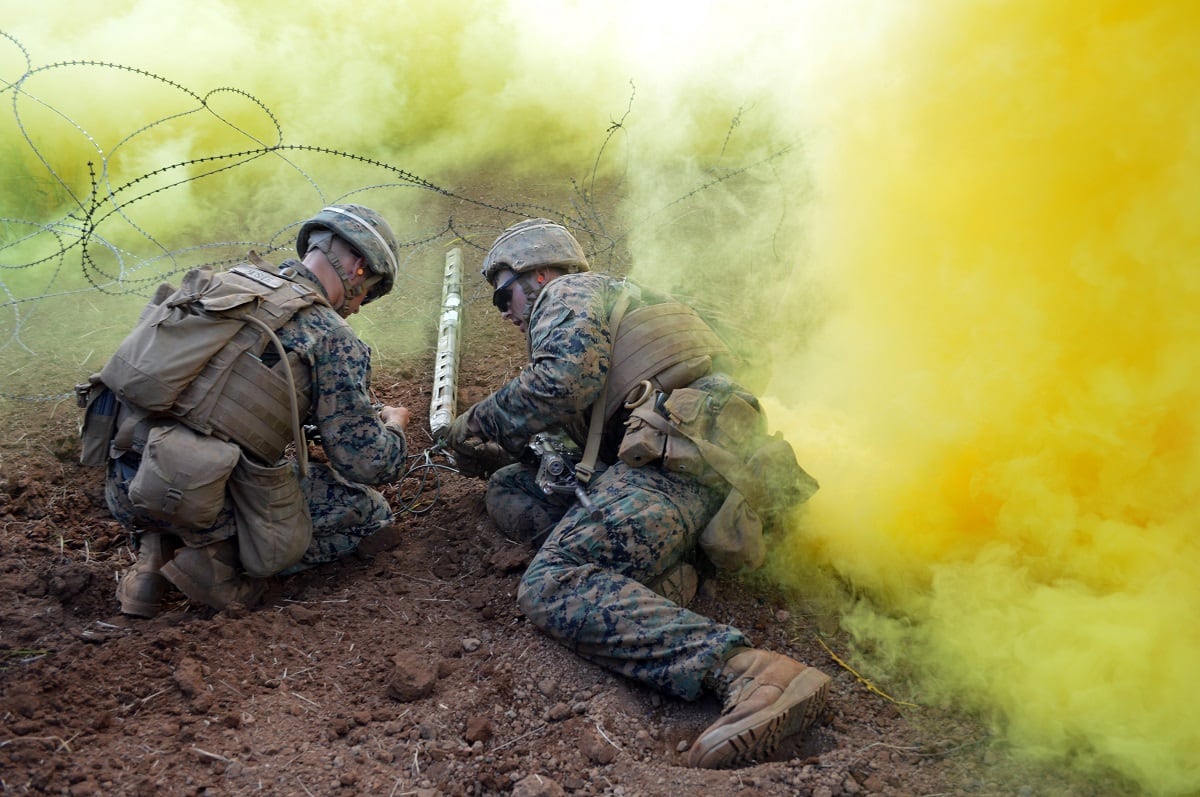Marine Corps success in combat always has been characterized by offensive operations, principally the rapid movement inland by Marine infantry in the attack.
If a natural or manmade obstruction stalled an attack, combat engineers were called forward to breach the obstacle quickly and effectively or bridge the wet or dry gap.
But Marine Corps combat engineers are no longer capable of providing this essential support. If called upon today to breach a minefield, reduce an obstacle or bridge a gap, the combat engineers would have nothing acceptable to send forward.
The Marine Corps has dangerously divested all its assault breaching and bridging capabilities. The engineers are still willing but are no longer capable.
Marine Corps divestment of needed engineering structure and equipment coupled with other debilitating losses in tanks, artillery, assault amphibious vehicles, helicopters, tiltrotor aircraft and strike/fighter aircraft were part of an unwise “divest to invest” strategy, voluntarily pursued by the Marine Corps to self-fund future, experimental capabilities.
The armored vehicle launched bridge, tank track width mine plow, armored combat earthmover and assault breacher vehicle were all jettisoned from the Marine Corps inventory over the past three years, apparently without consideration for future mobility requirements or for the protection of the individual Marine.
Marine Corps combat engineers no longer possess mobility and survivability equal to the force being supported. Without some armored protection, the engineers are exponentially more vulnerable to enemy small arms, mortars and artillery fires.
Unwise, or maybe better said, foolish divestments make it impossible for combat engineers to accomplish the essential missions of rapidly breaching minefields, barriers and obstacles; conducting route clearance under fire; rapidly laying down bridging for crossing streams and gaps and constructing roads and trails.
These engineering requirements are not limited to major land wars. Mines, damaged or destroyed bridges, and improvised explosive devices will inevitably confront Marine forces in any future conflict, small as well as large.
For those who think that U.S. Army or coalition forces will provide Marine forces the breaching and assault bridging capabilities needed is not just wishful thinking; it is dangerous thinking. We know of no service agreements that will support this assertion.
The rush to restructure and reequip the Marine Corps as an abstract regional force is codified in the Marine Corps concept document Force Design 2030. Prior to jettisoning needed structure and equipment, coupled with similar but external losses in the maritime prepositioning force and amphibious shipping, Marine air-ground task forces were trained and equipped to immediately deploy anywhere, across the spectrum of conflict. They were ready, relevant, and capable of responding to any crises or contingency as the nation’s premier 9-1-1 force.
Today, Marines remain ready to answer the call, but the capabilities needed for global response have been sacrificed as bill-payers for unproven organizations, equipment, and munitions narrowly tailored against one threat and in one location ― China’s navy in the western Pacific. The emasculation of Marine Corps capabilities and the myopic focus on a single enemy is a threat to national security.
The loss of all assault breaching and bridging capabilities significantly limits where Marine ground forces can be committed to combat, today and in the future.
Combat engineers no longer have the manpower and equipment to facilitate the unimpeded maneuver of Marine infantry through explosive and nonexplosive obstacles and across gaps.
The Marine Corps is gambling the mission and the lives of its Marines on the forlorn hope that someone else will answer the infantry’s call “engineers up” when pinned down and unable to maneuver through a minefield or across a river.
The recently published article by former Marine Corps Commandant Gen. Charles Krulak and former Commander United States Central Command General Anthony Zinni, offers a distinct alternative to Force Design 2030. Vision 2035 would restore the Marine Corps to its congressional mandated role as the Nation’s 9-1-1 force, capable of responding quickly and effectively to any threat worldwide.
A key component of the vision is a robust combat development process to determine the capabilities and requirements needed for global response in an age of precision munitions. Global response in “every clime and place” will require the restoration of assault breaching and bridging. The specific requirements will be determined through a rigorous combat development process.
United States Marines will encounter simple and complex obstacles, natural and man-made, when fighting a determined enemy, not just in the Indo-Pacific region but in all theaters.
Force Design 2030 has cheated Marine Corps combat engineers of the tools they need to breach these obstacles and ensure the freedom of movement Marine infantry and other elements of the force must have to fight and win.
The nation requires a Marine Corps ready, relevant, and capable of responding globally to any threat. The Marine Corps must have combat engineers with robust and effective assault breaching and bridging capabilities. Future battles, as past battles, will be decided by the combined elements of maneuver, fires, and information.
Lt. Gen. William Keys, retired, recipient of the Navy Cross for heroic actions in the Vietnam War, led the 2nd Marine Division when it had to breach explosive and non-explosive obstacles and bridge gaps to maintain the momentum of the attack into Kuwait during Operation Desert Storm.
Maj. Gen. Ronald Richard, retired, was the Operations Officer for the 2nd Marine Division during Operation Desert Storm.
This article is an Op-Ed and as such, the opinions expressed are those of the authors. If you would like to respond, or have an editorial of your own you would like to submit, please email Military Times Editor Andrea Scott.
Want more perspectives like this sent straight to you? Subscribe to get our Commentary & Opinion newsletter once a week.







